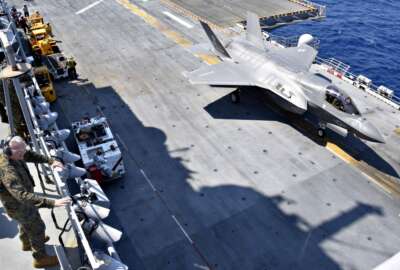Navy pursuing artificial intelligence to enable faster performance
The Navy, through its Office of Naval Research is pursuing artificial intelligence applications across a broad spectrum of the service’s responsibilities to m...
The Navy, through its Office of Naval Research, is pursuing artificial intelligence applications across a broad spectrum of the service’s responsibilities to man, train and equip, as well as warfighting, sustainment and readiness.
Such a wide range of applications and algorithms come with specific data requirements and data management. Curtis Pelzer, chief information officer at the Office of Naval Research, said ONR’s data resides in in several places on their network, and it’s the job of the data and analytics team to make sure information is provided and kept in the right sets.
AI can help reduce toil across the Navy, give autonomy with unmanned systems, and software codes can increase the speed and quality of human decision-making, according to Brett Vaughan, the Navy’s chief artificial intelligence officer and Office of Naval Research portfolio manager. Vaughan said any data could potentially fuel AI, but it depends on what problem one aims to solve. Users need to work through the AI stack, which he equated to a kind of ecosystem. Its components make up AI capability, and all of them must be healthy in order for an algorithm to work within the ecosystem.
“And by the inverse, if any of those are missing or deficient, you’ve got a toxic ecosystem and — the probability of success for your AI algorithm would decrease,” Vaughan said on Federal Monthly Insights — Cloud and Artificial Intelligence. “So the stack looks very different inside the Pentagon than it does on the bridge of a ship in the middle of Pacific Ocean, as you could imagine. So there’s a continuum.”
He said that someone who is training an algorithm will probably require cloud or a high performance compute environment. If they are deploying that algorithm rather than training it, the person may not even need cloud at all.
Getting the Navy to embrace AI will be a big lift for the CIO office, and Pelzer said they have embarked on a project to move existing workloads out of the data center and into the cloud by the end of the year — not just applications but also data.
“I think that puts us in a position to take advantage of the resources in the cloud to be able to scale our environment, on the demand that’s needed, to be able to house our data, and be able to provide the access to our data from AI tools, to be able to take advantage of that,” he said on Federal Drive with Tom Temin.
Having data and applications in the cloud enables faster capability, and it reduces how much additional storage hardware Pelzer and his team need to buy. That equates to greater scalability.
For Vaughan, the biggest cultural challenge for an organization like the Navy to embrace AI is the fact that is more industrial. But AI is digital, and unless the Navy can adopt good software, engineering or digital-first principles and practices, it will struggle, he said.
Copyright © 2024 Federal News Network. All rights reserved. This website is not intended for users located within the European Economic Area.
Amelia Brust is a digital editor at Federal News Network.
Follow @abrustWFED
Related Stories






